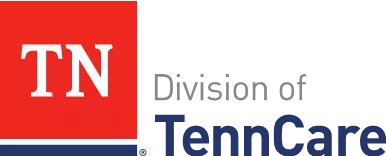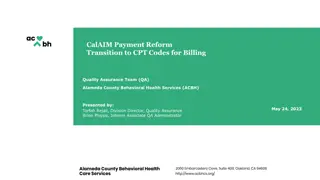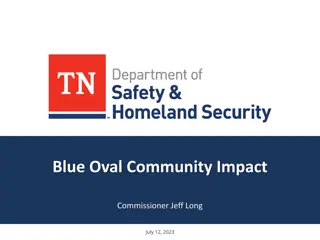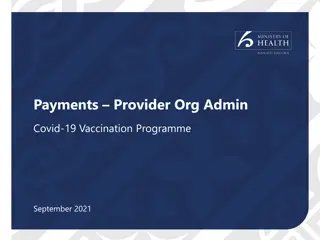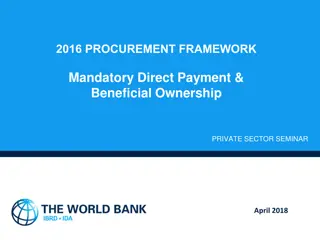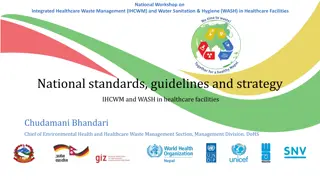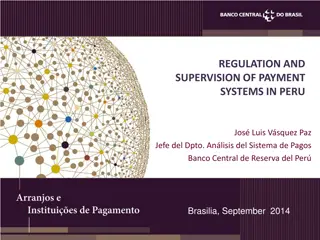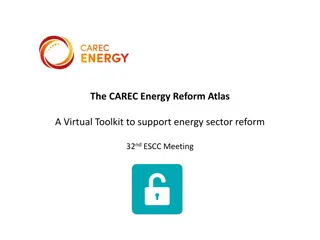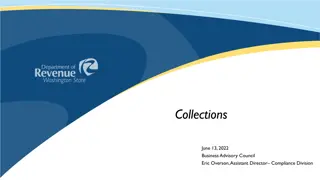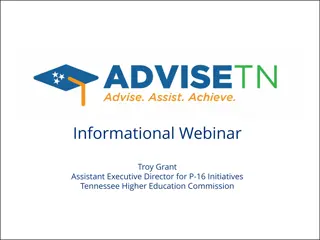Healthcare Costs and Payment Reform Initiatives in Tennessee
Healthcare costs in Tennessee are on the rise, impacting families and the economy. The state is actively pursuing payment reform strategies to enhance care quality and reduce costs, focusing on value-based payments and provider collaboration. Initiatives include the Tennessee Health Care Innovation Initiative and strategies like Patient Centered Medical Homes and Tennessee Health Link.
Download Presentation

Please find below an Image/Link to download the presentation.
The content on the website is provided AS IS for your information and personal use only. It may not be sold, licensed, or shared on other websites without obtaining consent from the author. Download presentation by click this link. If you encounter any issues during the download, it is possible that the publisher has removed the file from their server.
E N D
Presentation Transcript
TENNCARE Council on Autism Spectrum Disorder April 24, 2018 Update
Healthcare costs are increasing steadily Healthcare costs continue to grow at a faster rate than inflation Healthcare costs for a typical family of 4 have doubled in the last decade1 In the private sector, this squeezes out opportunities for investment and profit In government, healthcare costs soak up money that could be spent on other services such as education or safety. 2 1 2015 Milliman Medical Index
Tennessee Health Care Innovation Initiative We are deeply committed to reforming the way that we pay for healthcare in Tennessee Our goal is to payfor outcomes and for quality care, and to reward strongly performing providers We plan to have value-based payment account for the majority of healthcare spend within the next three to five years By aligning on common approaches we will see greater impact and ease the transition for providers We appreciate that hospitals, medical providers, and payers have all demonstrated a sincere willingness to move toward payment reform By working together, we can make significant progress toward sustainable medical costs and improving care 3
Tennessees Three Strategies Strategy elements Patient Centered Medical Homes Tennessee Health Link for people with the highest behavioral health needs Care coordination tool with hospital and ED admission provider alerts Examples Prevention Maintaining health Coordinating specialists Avoiding preventable episodes of care Connecting behavioral and primary care Perinatal Joint replacement Asthma exacerbation Colonoscopy Cholecystectomy ADHD Primary Care Transformation 75 Episodes of Care Episodes of Care Payment for value and quality in nursing facilities and home and community based services Training for providers Quality and acuity adjusted payments for LTSS services Value-based purchasing for enhanced respiratory care Workforce development Long Term Services & Supports 4
Objectives of PCMH and Tennessee Health Link PCMH: Holistic approach to care coordination for all patients Tennessee Health Link: Coordinated approach for highest-needs behavioral health members Ensure access to the full spectrum of needed care for all patients1, including those with long-term services and supports needs Foster joint decision making across the continuum of care providers Ensure access to a range of behavioral- health related supports aligned with level of need Access Foster joint decision making across behavioral and other health providers Joint decision making Instill awareness of quality, cost, and patient access across range of providers Instill awareness of interaction of behavioral and physical health needs including quality and cost impact Expected sources of value to include Appropriateness of behavioral health care setting / forms of delivery Choice of behavioral healthcare providers Referrals to high-value providers Medication management Mindsets Expected sources of value to include Appropriateness of care setting2 Appropriateness of treatment3 Improved patient treatment compliance Referrals to high-value providers Reduced readmissions Sources of value Primary care transformation aims to enhance coordination and integration across behavioral and physical health 1 E.g., Extended office hours, open scheduling 2 E.g., Reduction in unnecessary ED visits and inpatient admissions; shift to lower cost facilities 3 E.g., Improved medical management, appropriate length of stay, effective resource utilization 5
Care Coordination Tool A multi-payer shared care coordination tool will allow primary care providers to implement better care coordination in their offices. Hospital A Payer C Payer A Allows practices to view their attributed member panel ADT feeds Payer B Hospital B Alerts providers of their attributed members hospital admissions, discharges, and transfers (ADT feeds) and tracks follow-up activities Hospital C State eHealth connection State eHealth connection Hospital D Identifies a provider s attributed members risk scores Hospital E Claims data & Attribution Generates and displays gaps-in-care based on quality measures and tracks completion of activities Shared care coordination tool Care coordination information PCP PCP Tennessee Health Link Tennessee Health Link PCP PCP 6
PCMH Payment Model Overview Payment Objective $1 per member per month (PMPM) payment Not risk adjusted Each practice will receive this payment for their first year of participation Support initial investment in practice transformation Practice Transformation Payment Support practices for the labor and time required to evolve their care delivery models. Practices may hire new staff (e.g., care coordinators) or change responsibilities for existing staff to support practice transformation. Incentivize ongoing activity requirements Risk-adjusted PMPM payment Each PCMH will be assigned to a risk band based on the acuity of their membership MCOs will set payment levels for these bands, but average payment across all practices will be $4 PMPM Activity Payment Annual bonus payment available to high performing PCMHs High-volume (5,000+ member) PCMH practices: Shared savings based on total cost of care and quality metrics Low-volume (<5,000 member) PCMH practices: Bonus payment based on efficiency and quality metrics Encourage improvements in total- cost-of care and clinical outcomes Reward high quality providers Outcome Payment Payments in addition to the base primary care payments such as FFS 7
75 episodes of care will be designed and implemented over 5 years Design year & wave Design year & wave Design year & wave Episode Episode Episode Conduct disorder Skin and soft tissue infections Perinatal Lung cancer (multiple) Colon cancer Neonatal (Age 31 weeks or less) 2013 1 Asthma acute exacerbation Neonatal (Age 32 to 36 weeks) Neonatal (Age 37 weeks or greater) Total joint replacement 9 Female reproductive cancer Liver & pancreatic cancer 2016 6 COPD acute exacerbation HIV Pancreatitis Colonoscopy Cholecystectomy Drug dependence 2014 2 Diabetes acute exacerbation PCI - acute PCI non acute Sickle cell 2018 Renal failure Other major bowel (multiple) Spinal fusion Spinal decompression (without spinal fusion) Femur / pelvic fracture Knee arthroscopy GI hemorrhage EGD Hepatitis C Respiratory Infection Pneumonia UTI - outpatient UTI inpatient 10 GERD acute exacerbation 3 Kidney & urinary tract stones 7 Ankle non-operative injuries Wrist non-operative injuries Shoulder non-operative injuries Hemophilia & other coag. dis. 2015 Rheumatoid arthritis ADHD Knee non-operative injuries CHF acute exacerbation ODD Schizophrenia (multiple) Back / Neck pain Bipolar - chronic 4 2017 CABG Valve repair and replacement Bariatric surgery Breast biopsy Acute Seizure Bipolar acute exacerbation Syncope Hyponatremia/dehydration PTSD Anal procedures Pediatric acute lower respiratory infection Colposcopy Hysterectomy GI obstruction Appendectomy Hernia procedures 2019 11 Breast cancer, medical oncology Breast cancer, Mastectomy CAD & angina 8 Cardiac arrhythmia 5 2016 Otitis media Tonsillectomy Non-emergent depression Depression acute exacerbation Pacemaker / Defibrillator Anxiety Dermatitis / Urticaria 8 Updated June 20, 2017
Episodes estimated savings for 2015 is approximately $10.8 million due to episodes risk adjusted cost being less than projected medical trend of a 3% annual increase Comparison of Projected and Actual Avg. Risk-Adjusted Episode Cost, CY 2015 Estimated savings per Episode Number of Valid Episodes Total Estimated Savings Episode Type Projected Actual Percent Total - - - - 33,385 $10,822,268 Perinatal $6,893 $6,469 $425 6.2% 20,442 $8,684,619 Acute Asthma Exacerbation Total Joint Replacement $1,213 $1,074 $139 11.5% 12,614 $1,752,446 $12,481 $11,310 $1,171 9.4% 329 $385,203 9
Episodes estimated savings for 2016 is approximately $14.5 million due to episodes risk adjusted cost being less than projected medical trend of a 3% annual increase Comparison of Projected and Actual Avg. Risk-Adjusted Episode Cost, CY 2016 Estimated savings per Episode Number of Valid Episodes Total Estimated Savings Episode Type Projected Actual Percent Total - - - - 45,188 $14,548,603 Perinatal $7,100 $6,598 $502 7.1% 22,090 $11,065,302 Acute Asthma Exacerbation Total Joint Replacement $1,249 $1,067 $182 14.6% 12,939 $2,358,909 $12,855 $11,878 $977 7.6% 460 $449,608 Cholecystectomy $4,653 $4,591 $61 1.3% 2,110 $129,452 Colonoscopy $1,112 $1,082 $30 2.7% 2,929 $87,366 COPD $2,390 $2,253 $136 5.7% 4,116 $561,376 Acute PCI $9,376 $9,284 $92 1.0% 416 $38,279 Non-acute PCI $6,926 $8,033 -$1,107 -16.0% 128 -$141,689 10
Estimate of Penalties and Rewards, CY 2016, With One-Time Penalty Adjustment Total TennCare: Blue Care, Amerigroup, and United Rewards Penalties Balance $777,731 $359,947 $417,784 Perinatal Acute Asthma Exacerbation Total Joint Replacement $13,318 $50,558 ($37,240) $5,556 $29,513 ($23,958) $22,735 $25,997 ($3,262) Cholecystectomy $18,841 $22,299 ($3,458) Colonoscopy $55,552 $7,285 $48,267 COPD $27,989 $37,720 ($9,732) Acute PCI $15,171 $9,072 $6,098 Non-acute PCI Total $936,893 $542,393 $394,500 11
Thank You Questions? Email payment.reform@tn.gov More information: http://www.tn.gov/hcfa/section/strategic-planning- and-innovation-group 12
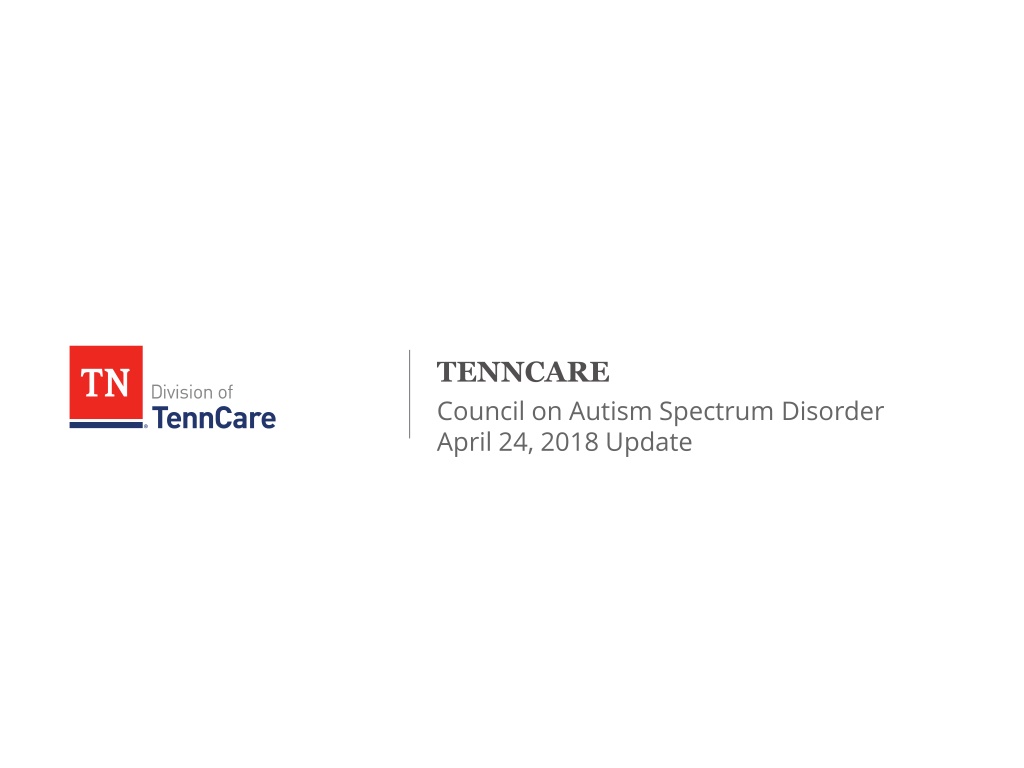
 undefined
undefined
